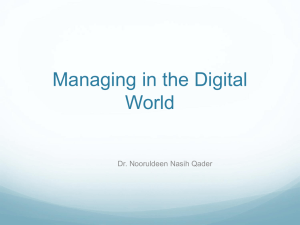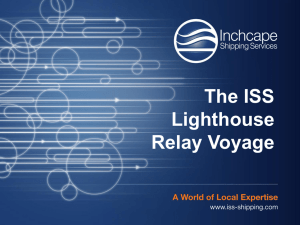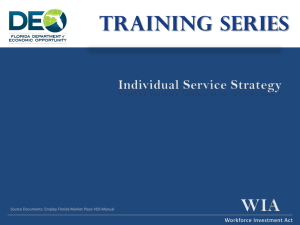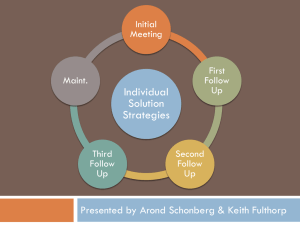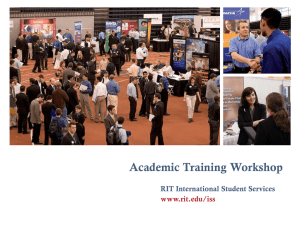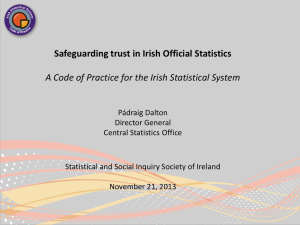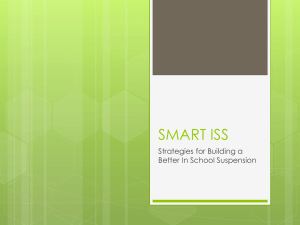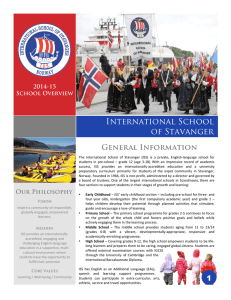Management Information Systems
advertisement
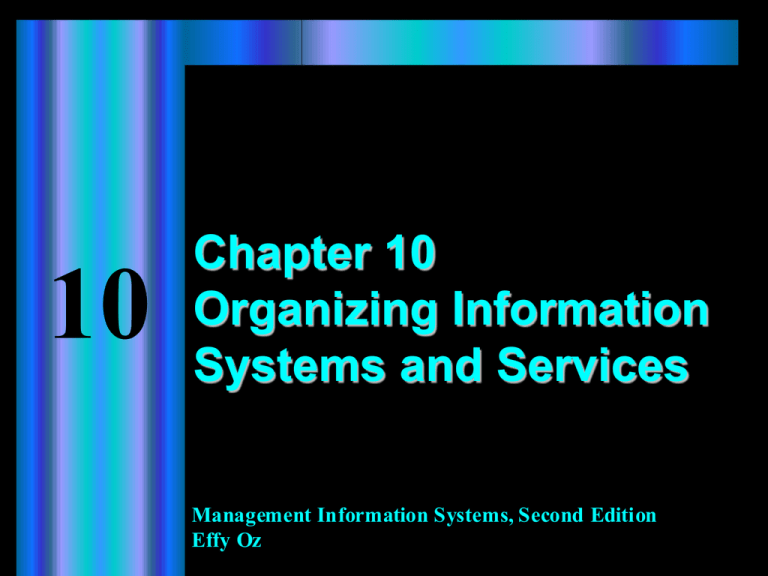
10 Chapter 10 Organizing Information Systems and Services Management Information Systems, Second Edition Effy Oz Learning Objectives When you finish this chapter, you will 10 Understand the different ways in which ISs are deployed in organizations. Be able to list and explain the advantages and disadvantages of each IS architecture. Know the importance of collaboration between IS managers and line managers, and understand the relationships between the two groups. Be able to describe career paths and responsibilities in the IS field. 2 Information Systems Architecture and Management Centralized Information Systems Architecture Mainframes dictated IS architecture be centralized 10 Advantages High degree of control Easy to maintain hardware, software, procedure, and operation standards Easy control of access to information Disadvantages Inflexible Lack of customization 3 Information Systems Architecture and Management 10 Figure 10.1 In centralized IS architecture, information resources are maintained on one or several large computers that are centrally controlled. 4 Information Systems Architecture and Management Decentralized Information Systems Architecture 10 Allows departments and remote sites independence in organizing and using their ISs Local IS department establishes infrastructure Disadvantages Difficult to share applications and data among units Expensive to maintain and service different systems 5 Information Systems Architecture and Management 10 Figure 10.2 In decentralized IS architecture, workers at different sites and departments (A, B, C) use information resources that are dedicated to their site or department. 6 Information Systems Architecture and Management Distributed Information Systems 10 Each unit selects and implements its own system. Remote units can share resources through communication lines. Many organizations changing to distributed architecture. Increased reliability and affordability of data communication and PC technology 7 Information Systems Architecture and Management 10 Figure 10.3 In distributed IS architecture, workers use the information resources of their own site or department, but can also use the resources of other sites or departments through communication lines 8 Information Systems Architecture and Management 10 Figure 10.4 Centralized vs. decentralized IS trade-offs 9 Information Systems Architecture and Management Centralized vs. Decentralized ISs: Advantages and Disadvantages 10 Advantages of Centralized IS Management Standardized hardware and software Easier training Encouragement of common reporting systems Effective planning of shared systems Easier strategic planning Efficient use of IS personnel Accommodation of tight control by top management 10 Information Systems Architecture and Management 10 Figure 10.5 Centralized management of ISs 11 Information Systems Architecture and Management Advantages of Decentralized IS Management 10 Better fit of ISs to business needs Timely responsiveness of IS units to business demands Encouragement of end user application development More innovative use of ISs Support for delegation of authority 12 Information Systems Architecture and Management 10 Figure 10.6 Decentralized management of ISs (in fully decentralized management, the central IS unit would not exist) 13 Information Systems Architecture and Management Trends in Information Systems Organization 10 Discarding Big Iron (mainframe computers) Switch to PCs brings distributed IS architecture benefits. Some companies keep mainframe for processing power. Reengineering with Information Technology Effort for breakthrough gains through radical business process and system changes. Almost always leads to integrating IT in all processes. 14 Organizing the IS Staff Central IS Organization Corporate IS team serves all units 10 IS Director oversees departments within IS System development and maintenance Information center Communications Data administration Research and development Involved in virtually every aspect of IT Steering committee oversees IS services 15 Organizing the IS Staff 10 Figure 10.7 An example of an IS unit’s organization with centrally managed ISs 16 Organizing the IS Staff Functional IS Organization Each unit fulfills IS needs independently. 10 Each business unit has one or several IS professionals who report to the unit manager. Funds come from unit budget. Small central unit can coordinate IS for departments that need help. 17 Organizing the IS Staff 10 Figure 10.8 An example of IS personnel locations in an organization with functionally managed ISs 18 Organizing the IS Staff The Best of Both Approaches 10 Many companies use elements of both central and functional IS management. Regardless of IS management, implementation depends on position of highest IS officer. Reports to VP: IS provides technical solutions Reports to CEO: IS more involved in strategic planning 19 Organizing the IS Staff 10 Figure 10.9 The number of CIOs reporting directly to a CEO has increased in recent years 20 Challenges for IS Managers and Line Managers Line Managers’ Expectations of an IS Unit Broad understanding of business activities 10 Prompt response to information needs Clear explanation of what technology can and can’t do Candid explanations of what IS can and can’t do Honest budgeting Single point of contact 21 Challenges for IS Managers and Line Managers IS Manager Expectations of Line Managers 10 Projected list of basic IS needs Clear explanation of business processes that need support once an IS manager is asked to develop a new system What features the business manager wants in the new system once general automation process is set 22 The Information Center Coordination and Control Hardware and software purchases 10 Application development Development and use of databases by end users Support Training and response to requests for help Help desk: Troubleshoot on demand 23 The Information Center 10 Figure 10.10 The help desk is an essential resource for IS users. 24 Chargeback Methods Two ways to treat cost of IS function Part of overhead cost: General shared expense 10 Chargeback system: Units charged for services Service Charges What is chargeable? Personnel hours Computer time External storage space Number of input and output operations Paper output 25 Chargeback Methods Desirable Chargeback Features 10 Accountability Controllability Timeliness Congruence with organizational goals Chargeback Criticism Expense may discourage IT initiatives High rates can be frustrating Overhead Expenditures Research and development Corporation-wide data communications 26 Careers in Information Systems Systems analyst Limited analysis of business needs and ISs 10 Updates and maintains existing ISs Designs new ISs Analyzes system requirements from user input Documents efforts and system features Provides specifications for programmers Agents of change Good persuasion and presentation skills 27 Careers in Information Systems 10 Figure 10.11 The multiple roles of a systems analyst. 28 Careers in Information Systems Database Administrator (DBA) Responsible for database of an organization 10 Planning and design Adoption of DBMSs and 4GLs Physical organization and storage Logical organization Schema development Data dictionary development and maintenance Security measures for access and proper use Failure recovery and back-up measures Updates and data integrity Interfaces of internal databases with other ISs Database personnel management 29 Careers in Information Systems Telecommunications Manager Responsible for computer networks 10 Acquisition Implementation Management Maintenance Troubleshooting Assesses future needs of the business 30 Careers in Information Systems Webmaster 10 Creates and maintains Web site and intranet pages Must know Web technology, business strategy, security Chief Information Officer (CIO) Responsible for all aspects of ISs Oversees IS research and development Oversees IS infrastructure development Serves as chief technologist Serves as chief agent of change 31 Careers in Information Systems 10 Figure 10.12 Nine commandments for successful, effective CIOs 32 Careers in Information Systems Chief Knowledge Officer (CKO) 10 Responsible for finding strategically important knowledge resources Accumulates, organizes, and retrieves information Chief Learning Officer (CLO) Independent Consultant Offers services to companies that lack qualified personnel for specific tasks 33 Ethical and Societal Issues Gasping for IT Skills Demand Keeps Growing 10 Projected 2 million additional designers, programmers, and maintenance and repair workers needed over the next seven years 1.8 million computer engineers, computer scientists, and systems analysts needed by 2006 Ironically, high demand and benefits not attracting students to IT programs 34 Ethical and Societal Issues Gasping for IT Skills One Strategy That Worked Irish government subsidized tuition for students in technological programs 10 Second largest exporter of software 60 percent of incoming university students enroll in technological programs per year Promoting National IT Should government subsidize technological education? Proponents: Benefits all society Detractors: Objectionable intrusion on personal pursuits and allocation of tax money 35

